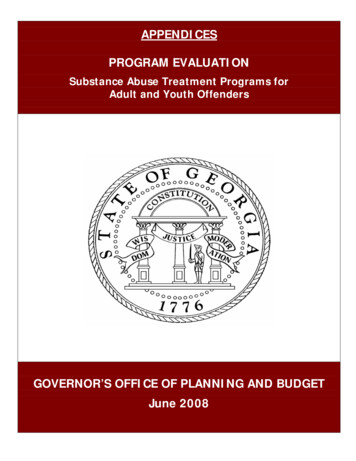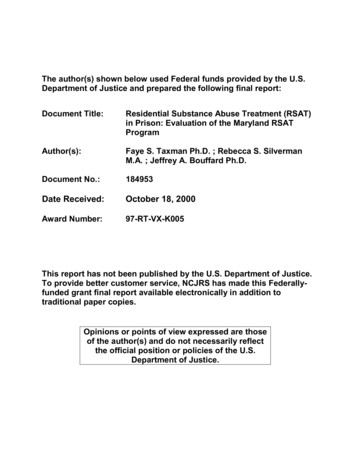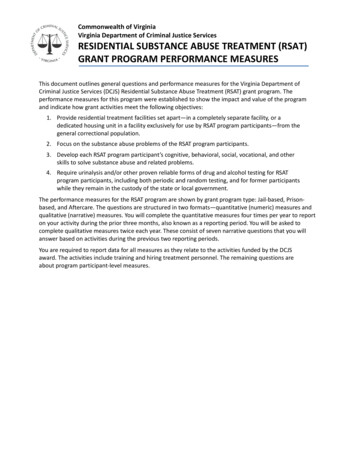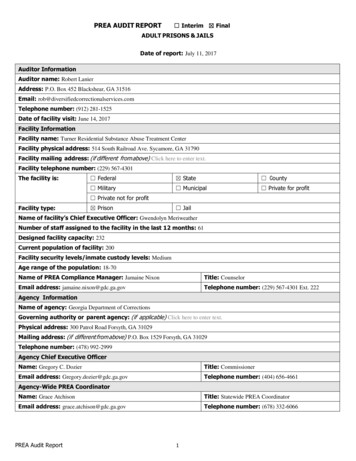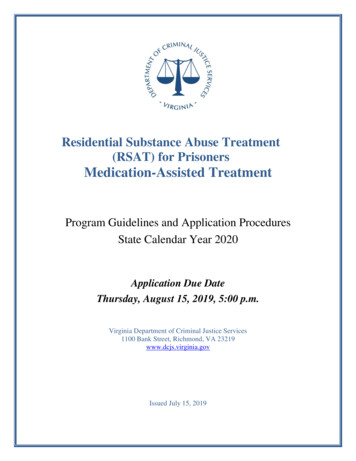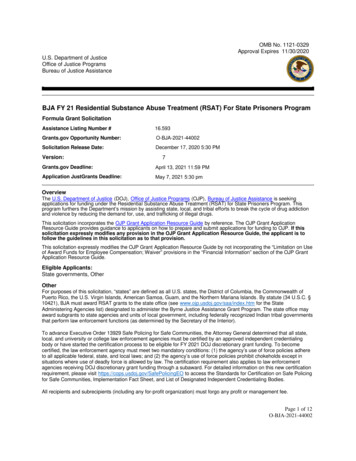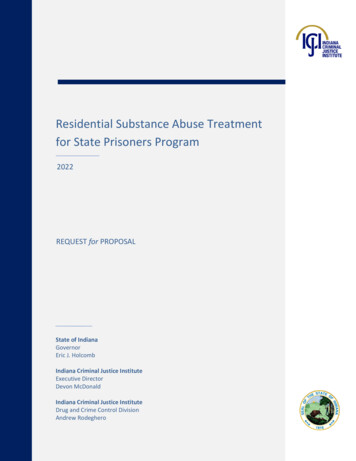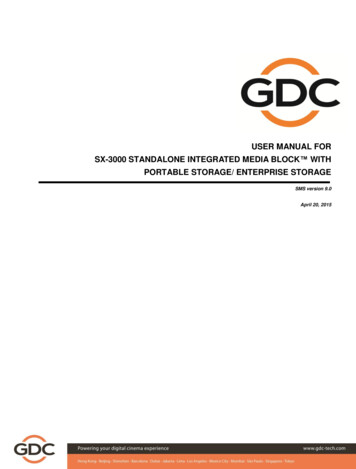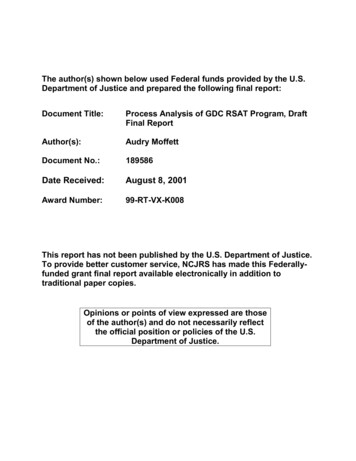
Transcription
The author(s) shown below used Federal funds provided by the U.S.Department of Justice and prepared the following final report:Document Title:Process Analysis of GDC RSAT Program, DraftFinal ReportAuthor(s):Audry MoffettDocument No.:189586Date Received:August 8, 2001Award Number:99-RT-VX-K008This report has not been published by the U.S. Department of Justice.To provide better customer service, NCJRS has made this Federallyfunded grant final report available electronically in addition totraditional paper copies.Opinions or points of view expressed are thoseof the author(s) and do not necessarily reflectthe official position or policies of the U.S.Department of Justice.
Process Analysis of GDCMAT ProgramDraft Final ReportPROPERTY OFNational Criminal JustiCe ReferenceSWh @.a%)” -.y.@*,.80x 6000/Rockviile, MD 20849-6000’.bPresented to:Programs Development UnitGeorgia Department of CorrectionsJuly, 2000Presented by:Wellsys CorporationACCEPTED AS FINAL REPORTThis document is a research report submitted to the U.S. Department of Justice. This reporthas not been published by the Department. Opinions or points of view expressed are thoseof the author(s) and do not necessarily reflect the official position or policies of theU.S. Department of Justice.
Wellsys Corporation4708 Elam Forest Dr.Stone Mountain, GA30083*404-299-9373404-299-9361 (fax)1-800-293-7322www.wellsyscorp.comwellsys 0wellsyscorp.comCORPORATIONNavigating directions for people and systems.GDC RSAT Process Evaluation Draft Final ReportPage -ii-This document is a research report submitted to the U.S. Department of Justice. This reporthas not been published by the Department. Opinions or points of view expressed are thoseof the author(s) and do not necessarily reflect the official position or policies of theU.S. Department of Justice.Wellsys CorporationJuly 17,2000
Table of Contents.Section I .Summary of Project .ExecutiveSumm;w.Section I1 .Substance Abuse and Criminality .Substance Abuse Issues .Prevalence and Incidence .Substance Abuse Issues .Treatment .Substance Abuse Issues .Recidivism .Spectrum Health ServiceslCiviGenics Inc. (SHS) .Background of company .Programs offeredby SHS in the GDC .Overview of proposed RSAT program offerings .GoalsoftheRSATprogram .vi111133555666Wellsys CorporationSummaryofProposalFramework of the RSAT process evaluationScope of work, involved partiesProgramsitesMethodology of the Process EvaluationIntewiewsReview of written records and documentationAdministration of a survey instrumentSite visits and observationExamination of computerized databasesMeansofachievinggoals.1.8899111112121314. 17.- 1 7. 18.20. 20. 23. 24. 25Section 111 .Participant referral and selection process for the RSAT ProgramEligibility criteria for participation in the RSAT ProgramProposed referral process of selected inmatesProblems identified with the RSAT Program referral processTentativeParoleMonthIssuesOther inappropriate referralsReferralprocessingeneralHow counselors refer inmates to the RSAT programGDC RSAT Process Evaluation .Draft Final ReportPage -iii-This document is a research report submitted to the U.S. Department of Justice. This reporthas not been published by the Department. Opinions or points of view expressed are thoseof the author(s) and do not necessarily reflect the official position or policies of theU.S. Department of Justice.Wellsys CorporationJuly 17. 2000
. 29.29SourceofreferralsResults of the problems with the selection and referral process. 30. 30. 30. 32. 33. 34. 34. 38. 39. 39. 41. 45.46. 46. 50. 51.51. P2. 54Section IV .Implementation of the RSAT ProgramSelectingprogramlocationsFacilities at the Four RSAT SitesInitial Program ImplementationOverview of staffing structureSelection and training of staffStaff selection criteria, requirementsTraining required. provided by GDC andlor SHSStaff-to-inmateratios at the RSAT sitesTimelines of MAT ProgramStatistics of MAT Program selor Rating Form Clinical Chart Storage and Retrieval e r 8nnin8p 1GapsinResources.Section VI .S l m m q l yand ConclusionsRecommendations5658.List of Figures.Figure 1 B A T program logic model24. 18.19. 21. 35. 58Figure2LocationsofRSATprogramsFigure 3 Substance abuse intervention programs within the GDCFigure 4 GDC substance abuse intervention programs flow chart.Figure 5 Flow diagram of initial RSAT referral processFigure 6 SHS organizational chart.Figure 7 RSAT program logic modelGDC RSAT Process Evaluation .Draft Final ReportPage -iv-This document is a research report submitted to the U.S. Department of Justice. This reporthas not been published by the Department. Opinions or points of view expressed are thoseof the author(s) and do not necessarily reflect the official position or policies of theU.S. Department of Justice.Wellsys CorporationJuly I?. 2000
List of Tables. 4. .27. .41.42. .43. .45. .48. .52Table 1 MAT prison locations, number of beds, and type of facility.Table 2 Reasons MAT referrals were found to be ineligible.Table 3 Instant offense of RSAT partidpants.Table 4 Drug of choice for RSAT partidpants.Table 5 Admissions to the RSAT ProgramsTable 6 Discharge dispositions of MAT participantsTable 7 Summary statistics for the Counselor Rating Form.Table 8 Average number of chart audits for the RSAT sites.Appendicesix 1ix 21x3Appenc ix 4Appenc lix 5RSAT evaluation interview protocolCounselor Rating Form (CRF)RSATscheduleAgreement of procedures between GDC and Board of Pardons and ParoleInmate diagnostic behavior problem tablelix 6 Substance involvement section from inmate diagnostic interviewix 7 Testing materials used in the RSAT programix 8 SHS chart review formlix 9 Current MAT charting policies, procedures, and formsGDC RSAT Process Evaluation Draft Final ReportPage -v-This document is a research report submitted to the U.S. Department of Justice. This reporthas not been published by the Department. Opinions or points of view expressed are thoseof the author(s) and do not necessarily reflect the official position or policies of theU.S. Department of Justice.IWellsys CorporationJuly 17,2000
eExecutive SummaryThis document reports the findings of a process evaluation of the Residential Substance AbuseTreatment (RSAT) program operating within the Georgia Department of Corrections (GDC).The process evaluation was conducted by Wellsys Corporation, under contract to the GDC.The RSAT program is provided by Spectrum Health ServicesKiviGenics (SHS), an independentvendor of health services operating in the GDC since 1994.There are seven RSAT programs operating at four prisons in the GDC system: Scott, Macon,Calhoun, and Pulaski State Prisons. A total of 310 beds are available for program participants.The report focuses on and is organized according to four aspects of the RSAT program:Proposal and development of the RSAT programReferral and selection processes of the RSAT programRSAT program implementationAftercare and discharge planninge-.0A variety of methods and data sources were utilized in the writing of this report, includinginterviews with GDC and SHS staff, examination of computerized databases, observation atservice deliverv sites. and examination of a varietv of written materials and research.Findings suggest that the RSAT program is operating in a way that is reflective of its design andthe intent of its designers. There appears to be a significant degree of fidelity between theactual and proposed programs regarding the structure, setting, and content of the programs.Further, both on-site SHS staff and correctional administrative staff express satisfaction withthe RSAT program itself. Benefits of the program cited by those interviewed included lowerrates of institutional misconduct and significant attitudinal and behavioral change asparticipants progress through the program. Weakness cited by both RSAT staff andcorrectional administrators focused on the selection and referral processes and the lack ofsufficient aftercare services once graduates are released from prison. Specific factors citedincluded a lack of communication between various entities within the GDC and a lack ofknowledge concerning the RSAT program among diagnostic and classification staff.Specific recommendations for the RSAT program are provided, and include the following:Address deficiencies with the MIS system to allow more complete and comprehensive1.data collection, retrieval, and reporting functionsImplement a standardized system of identifying inmates’ degree of substance use and2.involvement, so as to aid in referral and decision making concerning treatment need3.Refine and simplify the referral processAddress and resolve issues between various GDC units and the parole authorities4.5.Substantially increase the opportunities available for aftercare upon releaseCDC MAT Process Evaluation Draft Final ReportPage -vi-This document is a research report submitted to the U.S. Department of Justice. This reporthas not been published by the Department. Opinions or points of view expressed are thoseof the author(s) and do not necessarily reflect the official position or policies of theU.S. Department of Justice.Wellsys CorporationJuly 17, 2090
Section I - Summary of ProjectThis report documents the process evaluation of the Georgia Department of Correction’s (GDC)Residential Substance Abuse Treatment (RSAT) Program conducted by Wellsys Corporation.Wellsys Corporation is an Atlanta-based consultancy group with particular experience inprogram evaluation of not-for-profitorganizations and governmental agencies. WellsysCorporation, together with the Program Development Unit of the GDC applied for and receivedFederal funding to perform the process evaluation.Summary of ProposalA proposal for a local evaluation of Georgia Department of Correction’s(GDC) ResidentialSubstance Abuse Treatment (RSAT) Program was submitted for the September 15, 1998 cyclein response to the National Institute of Justice Solicitation of February, 1998. At that time noother local process evaluation of the GDC RSAT program was being conducted, and the GDCwas not at the time of the proposal receiving NIJ funds to conduct a local process evaluation.The overall goal of the process evaluation was to examine the FSAT program in sufficient detailthat the GDC has the information necessary to assess the program’s quality, efficiency, andeffectiveness and to provide the needed contextual framework for an outcome evaluation ofthe program. Specific goals of the process evaluation were:1.To describe the programs being implemented and the extent to whichthey are complete, consistent, and as intended, based on the programdesign.2.To identifyprogram deficits and opportunities for improvement.3.To determine what characteristics comprise a quality program, i.e., whatare the best practices.4.To identify important components for program replication.Framework of the RSAT process evaluationThe framework and structure of the K A T process evaluation directly follows the logic model ofthe S A T program, presented in Figure 1 below.GDC RSAT Process Evaluation Draft Final ReportPage -1-This document is a research report submitted to the U.S. Department of Justice. This reporthas not been published by the Department. Opinions or points of view expressed are thoseof the author(s) and do not necessarily reflect the official position or policies of theU.S. Department of Justice.Wellsys CorporationJuly 17,2000
inmates inneed ofpre-releaseSAtrea tm e ntprogram iswelldesignedandresourced Thenprogramshort termoutcomescan beachieved- - If programinmatesandprograma rematchedHThenprogramlong termoutcomescan beachievedis operatedwell andwith fidelityIf inmatesparticipateandperformwellHThenprogramgoals canbeachievedFigure 1 RSAT program logic model. The first five boxes of this model - the conditions - are the focus of this process evaluation,and the remaining three boxes - the results -will be the focus of a proposed outcomeevaluation. The conditions represent those elements that must be in place for the desiredprogram results to be realized. In this model, the “conditions”for the RSAT program are:needs driving the program - pre-release substance abuse treatment,what is planned to address these needs - program design and resources,proper matching of inmates to program selection process,how the program is implemented and operated - program quality andperformance, andhow inmates function in the program - inmate participation and performanceThese conditions determine the program’s short-term outcomes, long-term outcomes, andgoals. A general description of the process evaluation elements follow.Pre-Release Inmates Needs This area of the evaluation documents the needfor programmatic services in the context of understanding what role inmatecharacteristics and other factors, including substance abuse, play in offenderrecidivism, and what is needed to address these factors. The substance abuserelated factors are the focus of what the RSAT program design was intended toaddress.Program Design and Resources -This area of the evaluation documents howthe program was designed and planned to address the identified needs in a waythat is expected to achieve the desired results. This establishes the baseline--GDC RSAT Process Evaluation Draft Final ReportPage -2-This document is a research report submitted to the U.S. Department of Justice. This reporthas not been published by the Department. Opinions or points of view expressed are thoseof the author(s) and do not necessarily reflect the official position or policies of theU.S. Department of Justice.Wellsys CorporationJuly 17,2000
(what is intended) for comparing the actual program implementation andoperation. The primary methods for collecting this information includedreviewing program documentation including the program proposal and logicmodel. Understanding how the program resources were determined andintended to be applied is important in understanding the inputs that go intoestablishing and operating the program.Inmate Selection - Documenting general inmate pre-release needs is importantbut does not, in itself, identify which inmates would be considered bestcandidates for participation in the program. Therefore, it is important toexamine the selection process to understand which inmates are or are notchosen for the program and why or why not.Program Quality and Performance -The intent of this area of the processevaluation is to clearly describe and document the program as it has beenimplemented and being operated at each of the sites. While the previous threeareas provide a context and a baseline, this and the following area are the heartof the process evaluation. Fully understanding the program implementation andperformance at each site individually and comparing sites to each other andwith the comparison site will provide the basis for understanding a) how wellthe programs conform to the program design, b) where there are deficits thatmay require design or implementation changes, c) what needs to be consideredfor program replication, d) the nature of staff performance, and e) what are th'eprogrammatic contributors to inmate outcomes.Inmate Participation and Performance - This is the second major area of theprocess evaluation that will describe and document how the inmates,individually and collectively, are participating in the various program elementsand their progress in preparing for release. Both the level and quality of inmateparticipation needs to be understood in the context of each programmaticelement. This will form the basis of understanding the inmates' preparation forrelease, and ultimately, the outcomes they realize.Scope of work, involved partiesProgram Sites0Currently, a total of 3 10 beds are provided for the program through seven RSAT programslocated at four specified state prison inmate dorms reserved for the RSAT program. Theprograms all began operation during the first two weeks of January, 1998. Six of the programsserve male inmates and one program serves female inmates. The process evaluation wasimplemented at each of the four program sites.GDC RSAT Process Evaluation Draft Final ReportPage -3-This document is a research report submitted to the U.S. Department of Justice. This reporthas not been published by the Department. Opinions or points of view expressed are thoseof the author(s) and do not necessarily reflect the official position or policies of theU.S. Department of Justice.Wellsys CorporationJuly 17,2000
Table 1 RSAT prison locations, number of beds, and type of facility.StatePrisonNo. ofMaleFacilityBedsFemaleFacilityThe RSAT programs are housed in state prison facilities in middle and south Georgia, asdisplayed in the map below.AA A Pulaski State PrisonMacon State PrisonScale Legend1Figure 2 Locations of RSAT programs.GDC RSAT Process Evaluation Draft Final ReportPage -4-This document is a research report submitted to the U.S. Department of Justice. This reporthas not been published by the Department. Opinions or points of view expressed are thoseof the author(s) and do not necessarily reflect the official position or policies of theU.S. Department of Justice.Wellsys CorporationJuly 17,2000
eThe process evaluation design, planning, and implementation represent a collaboration amongthree entities who will comprise the process evaluation team. These entities are:GDC Program Development Unit,CiviGenics/Spectrum Health Systems, Inc. (SHS), andWellsys CorporationThe GDC Program Development Unit is responsible for the RSAT program and itsimplementation and for the inmates participating in the program. Responsibility for theprogram participants shifts to the State Board of Pardons and Parole when the inmates arereleased. CiviGenics/SpectrumHealth Systems, lnc. (hereafter referred to as SHS) is currentlyproviding the programmatic services for GDC’s RSAT programs. Wellsys Corporation hadprimary responsibility for the implementation of the process evaluation.Methodology of the Process EvaluationThe process evaluation of the E A T programs was accomplished using a variety of datacollection methods. These fall into five basic areas: Interviews; review of written records anddocumentation; administration of a survey instrument; site visits and observation; andexamination of computerized databases. Each of these are discussed briefly in turn, withparticular issues addressed in the report as needed.InterviewsA semi-structured interview format was developed by Wellsys Corporation in an attempt toprovide structure and consistency in the interview process (a copy of the interview can befound in Appendix I). The interview format was used in discussions with GDC administrativepersonnel, RSAT program directors, assistant directors, and assorted RSAT counselors. Theinterview focused on five domains related to the interviewee: Involvement with the MATProgram; prior experience, duties within the RSAT Program; process of implementation;andgeneral impressions.In addition to the use of this interview, many less formal interviews and discussions occurredwith individuals who, in one way or another, are involved in the RSAT programs.Review of written records and documentation0Written materials were requested and obtained from SHS, GDC, and a host of other sources.These materials included, but were not limited to: Program manuals and curricula; grantrelated documents; staffing materials; training materials; documents related to organizationalGDC MAT Process Evaluation Draft Final ReportPage -5-This document is a research report submitted to the U.S. Department of Justice. This reporthas not been published by the Department. Opinions or points of view expressed are thoseof the author(s) and do not necessarily reflect the official position or policies of theU.S. Department of Justice.Wellsys CorporationJuly 17, 2000
structure; reporting and oversight materials; and program evaluation documents. In addition, areview of current and retired clinical charts at each of the four G A T sites was conducted.Literature searches were performed to access relevant academic and governmentalpublications. Information was also obtained through use of various Internet sites, most notablyvia the Sourcebook of Criminal Justice Statistics and the Bureau of Justice Statistics.Administration of a survey instrumentWellsys developed the Counselor Rating Form (CRF) survey as a means of assessing theprogress of individual participants in the RSAT Program. The CRF consisted of 20 questions,grouped into four general areas: motivation; degree gf participation; performance; andpredicted outcomes concerning crime and drug use. The CRF utilized a Likert-type responseformat, ranging from a 1 (Very Low) to a 5 (Very High). The instrument, which can be found inAppendix 2, was completed by the RSAT counselors at each of the four sites, with thecounselors completing one CRF for each of the participants on their caseload. A total of 244completed CRFs was received, providing a “snapshot”of an entire population of current RSATparticipants at a given point in time.0Site visits and observationEach of the four RSAT sites was visited on af least three occasions by members of theevaluation team. These visits provided opportunities to observe group sessions, meet withRSAT Program participants, interview RSAT staff members, review documentation, and meetwith GDC correctional administrators. In addition, a member of the evaluation team attendedpart of the SHS Georgia Annual Training event and also attended an RSAT Program graduationceremony.Examination of computerized databasesThree sources of computerized databases were identified. The degree of success in gainingaccess to the data differed greatly depending upon the source of the data.eThe first source was SHS, which provided their screening and tracking databases. Thesedatabases are used respectively to record the referrals and track participants for the programsthat administered by SHS within the GDC. These databases, though flawed by significantamounts of missing data, were relatively simple and easy to obtain and access.GDC RSAT Process Evaluation Draft Final ReportPage -6-This document is a research report submitted to the U.S. Department of Justice. This reporthas not been published by the Department. Opinions or points of view expressed are thoseof the author(s) and do not necessarily reflect the official position or policies of theU.S. Department of Justice.Wellsys CorporationJuly 17, 2000
0The second source of data was the Mainframe Support Unit of the GDC. We approached thisunit in an effort to obtain data using the Offender Tracking Information System (OTIS)database. OTIS is the online system used within the GDC to keep track of almost every piece ofinformation related to offenders in the GDC system. Periodically the information is uploaded totape-based media for archival purposes, Due to problems with this uploading procedure, themost recent dataset available for our review was uploaded in September of 1997,The third and final source for computer-based data was OTIS summary information concerninginmate participation in various GDC programs, including substance abuse treatment programs.Due to limitations with the report generator, this procedure could produce reports coveringonly a %month window. The data also was somewhat redundant with that provided in theannual and semi-annual reports provided by SHS and GDC.CDC RSAT Process Evaluation Draft Final ReportPage -7-This document is a research report submitted to the U.S. Department of Justice. This reporthas not been published by the Department. Opinions or points of view expressed are thoseof the author(s) and do not necessarily reflect the official position or policies of theU.S. Department of Justice.Wellsys CorporationJuly 17, 2000
Section I1 - Substance Abuse and Criminality-Substance Abuse Issues Prevalence and IncidenceWidespread abuse of drugs and alcohol is considered to be a public health issue of primaryimportance in the United States. Whereas substance abuse is considered alarmingly high inthe general population, statistics indicate that it has reached epidemic proportions amongjailed and incarcerated individuals. In 1997 there were approximately 11.5 million arrests foralcohol-related offenses in the United States, representing 23%of all arrests. Over 180,000ofthese arrests occurred in Georgia, fully 21% of in-state arrests. The 1997 Survey of Inmates inState and Federal Correctional Facilities found that 51%of respondents reported the use ofalcohol or drugs at the time of their offense (Bureau of Justice Statistics Special Report,January, 1999). Fully 67% of adult arrestees in Atlanta (Georgia) tested positive for illicit drugsat the time of arrest (Sourcebook of Criminal Justice Stutistics, 1998,p. 367; p. 370). Close to70%of all State Prisoners in 1997 reported having ever used illicit drugs regularly,with 56%reporting illicit drug use in the month prior to their arrest, compared to 62%and 50%respectively in 1991 (Bureau of Justice Statistics Special Report, January, 1999). Approximately60% of the federal prison population is composed of individuals convicted of drug offenses.Thirty-sevenpercent and 33 percent of state prisoners report using alcohol and drugsrespectively at the time of offense. Examining the amount of crime linked directly to alcohol andlor drugs provides a conservativeestimate of drug-involved criminal activity. Taken together, drug trafficking,drug possession,and DUI account for about 18%of the total incarcerations within Georgia Prisons (counting themost serious instant offense; CDC Monthly FtfsonsReport for May, 2000). This statistic does nottake into consideration the vast amount of criminal activity peripherallyrelated to themanufacture, distribution, procurement, and consumption of drugs. “Among State Prisoners,the incidence of alcohol or drug use at the time of offense showed little variation by offensetype, ranging from 52% of violent offenders to 56% of public-order offenders. Among specificoffense types, only weapons (42%), fraud (43%) and sexual assault (45%) offenders had aminority reporting the influence of alcohol or drugs at the time of their offense” (Bureau ofJustice Statistics Special Report, January, 1999, p. 2). In fact, the specific offenses most closelyrelated to alcohol use at the time of the offense were assault, murder, manslaughter, andsexual assault (Bureau of Justice Statistics Special Report, January, 1999). Taken together,these statistics indicate that fully 75%of all prisoners can be characterized as alcohol or druginvolved offenders (Bureau of Justice Statistics Special Report, January, I999),making clear thatthe majority of criminal activity is related the abuse of either drugs or alcohol.GDC RSAT Process Evaluation Draft Final ReportPage -8-This document is a research report submitted to the U.S. Department of Justice. This reporthas not been published by the Department. Opinions or points of view expressed are thoseof the author(s) and do not necessarily reflect the official position or policies of theU.S. Department of Justice.Wellsys CorporationJuly 17,2000
Substance Abuse Issues - Treatment0The link between substance abuse and criminality is well established, although not completelyunderstood. As shown above, statistics indicate that a high proportion of off
Treatment (RSAT) program operating within the Georgia Department of Corrections (GDC). The process evaluation was conducted by Wellsys Corporation, under contract to the GDC. The RSAT program is provided by Spectrum Health ServicesKiviGenics (SHS), an independent vendor of health services operating in the GDC since 1994.
